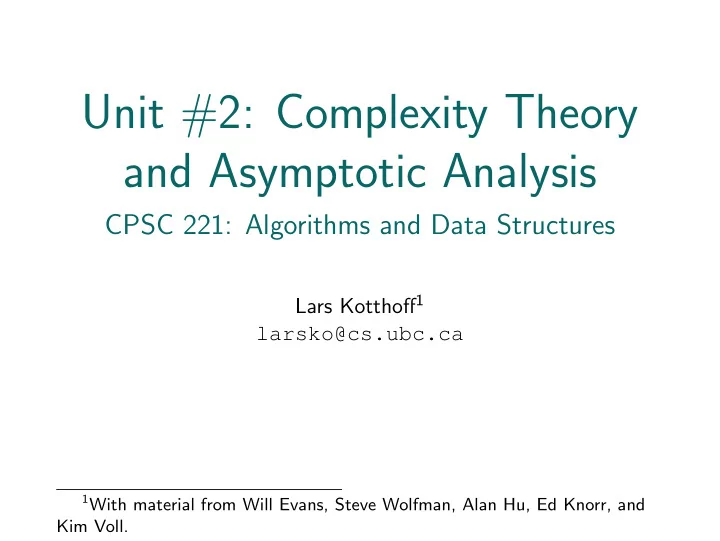

Unit #2: Complexity Theory and Asymptotic Analysis CPSC 221: Algorithms and Data Structures Lars Kotthoff 1 larsko@cs.ubc.ca 1 With material from Will Evans, Steve Wolfman, Alan Hu, Ed Knorr, and Kim Voll.
Runtime Example #8: Longest Common Subsequence Problem: Given two strings ( A and B ), find the longest sequence of characters that appears, in order, in both strings. Example: A = search me B = insane method A longest common subsequence is “ same ” (so is “ seme ”) Applications: DNA sequencing, revision control systems, diff , . . .
Example #9 Find a tight bound on T ( n ) = lg( n !) .
Aside: Who Cares About Ω(lg( n !)) ? Can You Beat O ( n log n ) Sort? Chew these over: ▷ How many values can you represent with n bits? ▷ Comparing two values ( x < y ) gives you one bit of information. ▷ There are n ! possible ways to reorder a list. We could number them: 1 , 2 , . . . , n ! ▷ Sorting basically means choosing which of those reorderings/numbers you’ll apply to your input. ▷ How many comparisons does it take to pick among n ! numbers?
Asymptotic Analysis Summary ▷ Determine what is the input size ▷ Express the resources (time, memory, etc.) an algorithm requires as a function of input size ▷ worst case ▷ best case ▷ average case ▷ common case ▷ Use asymptotic notation, O, Ω , Θ , to express the function simply
Problem Complexity The complexity of a problem is the complexity of the best algorithm for the problem. ▷ We can sometimes prove a lower bound on a problem’s complexity. To do so, we must show a lower bound on any possible algorithm. ▷ A correct algorithm establishes an upper bound on the problem’s complexity. Searching an unsorted list using comparisons takes Ω( n ) time (lower bound). Linear search takes O ( n ) time (matching upper bound). Sorting a list using comparisons takes Ω( n log n ) time (lower bound). Mergesort takes O ( n log n ) time (matching upper bound).
Problem Complexity Sorting: solvable in polynomial time, tractable Traveling Salesman Problem (TSP): In 1,290,319km, can I drive to all the cities in Canada, visiting each exactly once, and return home? www.math.uwaterloo.ca/tsp/ Checking a solution takes polynomial time. Current fastest way to find a solution takes exponential time in the worst case. Are problems in NP really in P? $1,000,000 prize
Problem Complexity Searching and Sorting: P, tractable Traveling Salesman Problem: NP, intractable 2 Kolmogorov Complexity: Uncomputable Kolmogorov Complexity of a string is the length of the shortest description of it. Can’t be computed. Pithy but hand-wavy proof: What’s: The smallest positive integer that cannot be described in fewer than fourteen words. 2 Assuming P ̸ = NP.
Recommend
More recommend